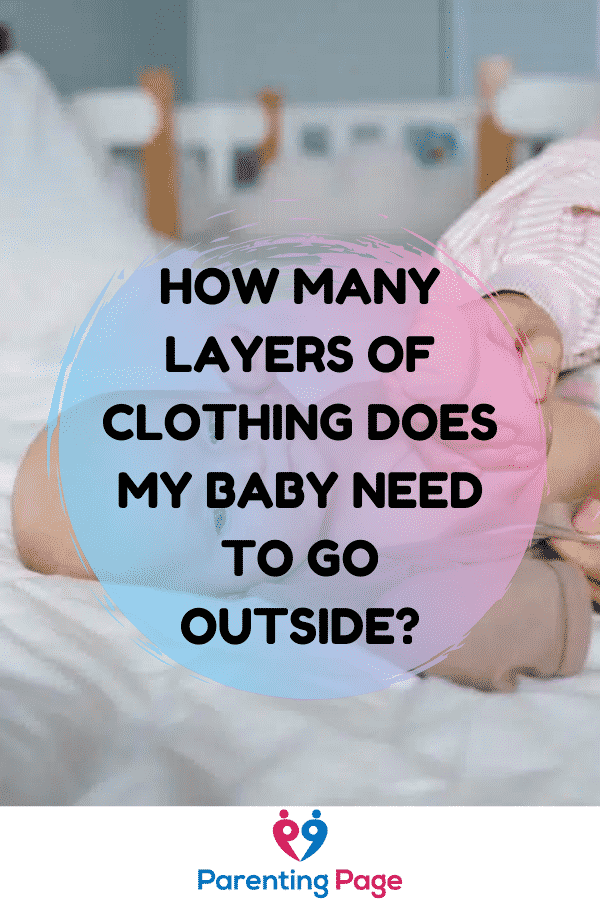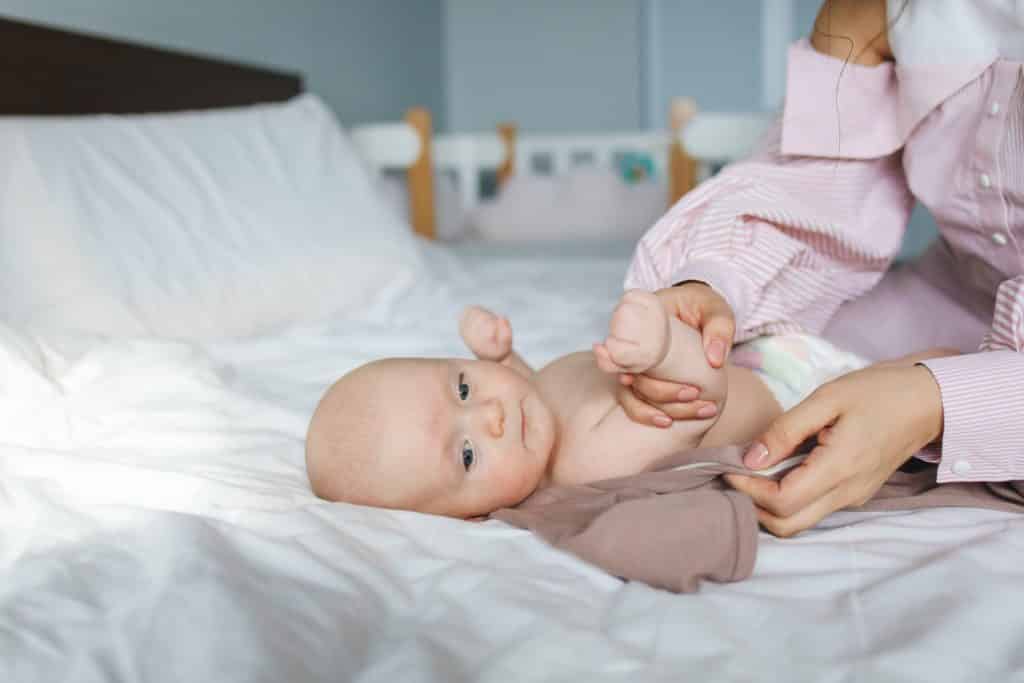Table of Contents
Getting the bundling right on newborns and knowing how many layers of clothing are necessary is important because infants are not fully able to regulate their heat and adjust to the conditions the way adults can, and they don’t have any of the communication skills to tell you when they need help.
Many new parents struggle and stress about dressing their baby and taking them out, wondering if they will be too hot, or too cold, never really sure if they are getting it right.
It can be especially hard in some states where the temperature can change rapidly, or a strong wind turns the day on its head, catching parents out, sometimes on the go with nothing on hand to address the situation.
So how do you identify how many layers are needed to dress your baby when you go outside?
What parents learn (sometimes the hard way) is that the best way to dress a new baby is by bringing a bag stuffed with helpful items along with you. You can’t know exactly what the outside is going to be like in order to dress a baby perfectly before you go out. It takes some creative planning and flexibility to be able to change things up on the fly.
As your baby grows and strengthens your bag will become lighter and easier to pack, until one day they are toddlers and you can head off with just a little pack. For now, you’ll be needing as much as you can get your hands on in your supply bag, including seconds, just in case of messy accidents.
Here are some essentials to go into your baby carry bag:
- Socks (at least two pairs)
- Long sleeve shirt/onesie
- Short-sleeved shirt/onesie
- Singlet
- Pants
- extra blankets
- Swaddles
- Jumper/jacket/vest
- Hats (sun and warm)
- Extra nappies
- Nappy rash cream
How you travel
Car travel
Keep in mind that traveling in a car can be tricky as you will momentarily be in cold weather getting in, then be protected and temperature controlled until you reach your destination. Bulky jackets and coats make buckling child seats difficult to think about putting these on when you need them, rather than over-dressing your bub in the car. Keep in mind too that sunlight through a car window can be hot, even stuffy, even on a milder day.
If you have a pram it’s easy to sling the bag over the pram handle or make use of the storage underneath.
Prams and Pushers
Pram blankets are great to drape over your little one to keep in warmth and block chilly winds, but can also double as change mats and rugs to sit on so having more than one is a good call, especially if they are made from different materials and are different weights. Swaddles or muslin cloths are great for multiple uses as well including sun shades, breastfeeding covers, and swaddling if your little one is restless. Because they are light and breathable they are great covers for warmer weather.
Prams also give you the option to attach rain guards which are perfect on rainy days and also protect from wind and glaring sun.
Carrying your bub
Slings and carry harnesses are a great way to keep your little one close. They will also get the benefit of your body temperature regulation. Make sure you can always see their face and their mouth and nose are not blocked by fabric or blankets you might use to help keep them warm.
Ideas on how to dress your baby for the weather
Layers are a great way to dress your baby if the season is cool or in between. Basically, dress them in one more layer than you are wearing yourself. Singlets are a great base layer in all weather conditions as they keep the chest and torso warm and are light enough that they won’t be uncomfortable with other items on top. It also means that if you need to change your baby’s clothes they have that warm layer remaining on as you change the top layer/s. In summer you can strip your bub down to just the singlet if they need to cool off, or to have some water play.
Pay attention to the weight of the material when you are buying clothes as some are warmer than others. Also, pay attention to if your baby is fussy in certain clothes. Having a calm baby when you are out and about means less stress for everyone so it’s good to know in advance if they are going to try to wiggle out of certain fabrics so you can avoid them if you’re going out.
One thing that is really important to maintain your child’s healthy temperature (for safety and comfort) is staying dry. Wet clothes can cause hypothermia even if the weather is not that cold. Make sure you change your baby’s diaper frequently and have a spare set of dry clothes available if there are any accidents. If you get stuck without a new nappy, or with wet clothes, change them anyway. Use a blanket, or even your own clothes as a quick wrap around their body until you can get supplies, and don’t be shy about asking another parent for a helping hand, most have a nappy or two they can spare if you are caught out.
No matter what the temperature is, always protect your baby from the sun by using a hat or stroller canopy. Babies under six months don’t have the natural ability to protect from sunlight yet, so using sunscreen lotions won’t help them. In times of high UV, it’s best to keep them indoors or fully shaded when out and about. You can find UV screening materials for covers and slings as well.
What are the signs your baby isn’t comfortable?
Whether it is scorching out or frosty, your priority is to keep your little one comfortable. Because your baby can’t tell you when they are uncomfortable it’s important to pay attention and recognize the signs of discomfort easily. It can be tough because they may grizzle for any number of items, soiled nappy, wanting milk, having gas, but do put it on your list of things to check for when your baby is restless.
When too warm baby seems:
- Flushed
- Sweaty
- Breathes faster
- Irritable
- Dehydrated (you’ll see a decrease in wet nappies or darker colored urine)
In extreme cases overheating may result in heatstroke.
If your little one looks overheated, take off some layers and stay inside if that’s suitable. Use a fan or a cool wet cloth to help soothe them and contact your doctor if they are not able to cool down. If your baby needs a swaddle to sleep you might want to strip them down to just a singlet beforehand to prevent them getting too warm in summer, unless you have an airconditioned room.
When too cold baby seems:
- Cool to touch, especially their neck and back
- Still or quiet
- Lethargic
- Pale
Babies lose a lot of heat from their heads, hands, and feet so a great way to bundle them in cooler months is a warm hat and socks. In extreme cases being too cold can lead to hypothermia or frostbite. If your baby has a number of the above symptoms at the same time, act quickly. The fastest way to warm them up is to give them direct skin-on-skin contact with you, so your body will regulate the heat for you both and get their temperature up to normal. Wrap a blanket around you both and make sure there are no wet clothes or blankets on their skin.
For frostbite check any exposed areas, especially fingers, nose, and toes. Affected areas may look white or pale gray and blistered. Do not use hot water or get close to heaters, instead get them close to your skin and use your heat as well as blankets to gently warm them.
How do I cover my infant during sleep?
Keeping your baby warm at night is a problem in homes that don’t have adequate heating as using blankets is a SIDS risk. Instead, dress your baby in warm pajamas. Most will have attached foot covers, and even hand covers to help retain body heat. Swaddling your baby will keep them warm and snug through the night. There are also specially made baby sleeping bags (such as Ergo bags), that your child can safely be zipped into. You can also add layers with a singlet or undershirt. Always use baby-safe mattresses which are flat and firm with only one fitted sheet.
What type of clothes should newborns wear?
Stretchy jumpsuits with buttons in front are ideal and shirts with envelope necks. These allow a baby to move, flap, kick and wiggle without pulling or riding up. Zipper jumpsuits also make dressing quick and simple. Look for soft fabrics that are easy to care for (you don’t have time to iron).
Envelope necks allow you to pull the neck down with your thumbs in the corners and fully open it so that if there is a spoiled area below, you can take the whole outfit off over the baby’s legs, without having to pull the soiled section up over their face, possibly getting them dirty in the process.
Be sure to remove any loose threads and avoid buying clothes with beading, drawstrings, ties, and attachments. Also look for the low fire danger label, especially for sleepwear.
How to dress an infant?
Most moms (and even infants) find dressing and undressing somewhat distressing. To help out, it pays to create the right space in advance. The more composed you are, the less stressful the process will be for you and your baby. Here are some guidelines on how to dress your newborn:
- Make sure the room you are changing in is a nice temperature.
- Use a surface texture your baby really loves. This might take some trial and error to find something that is really comfortable for them to lay on.
- Have a nappy or fast absorbing cloth on hand to use in the event of an open wee. Some babies will urinate as soon as they feel fresh air, meaning everything gets instantly soaked around them, including you!
- Support your infant’s head when stretching clothes over their head. It’s a shock if they are knocked or bumped.
- Be cautious not to touch your infant’s face while pulling clothes over their head- most babies get upset when clothes scrape their faces.
- Go slowly and gently with arms and legs. Getting wiggly limbs through is a delicate process. You can put your arms through the sleeve or leg hole and gently guide them through.
- For jumpsuits, lay the open suit down and place your baby on top rather than try to slide it around their small body.
- If you are going outside, make sure that your infant’s arms and legs are covered, it’s a good way to protect them from the sun.
- Placing toys within reach can help distract them, you can talk through the dressings and undressing process in a fun way and engage with them about what you are doing and what is happening, or sing or play music to make it a fun time together.
Be safe and make sure that your baby is secure if you are changing on a high area, like a changing table. For baby’s that are especially squirmy, you are better to change them on the floor.
Keeping your baby safe and comfortable is a high priority that can be stressful to new parents. Checking on the signs and being ready and flexible to change will help you over the worse of it.
SEE ALSO: Why are infants supposed to wear a hat all the time?


